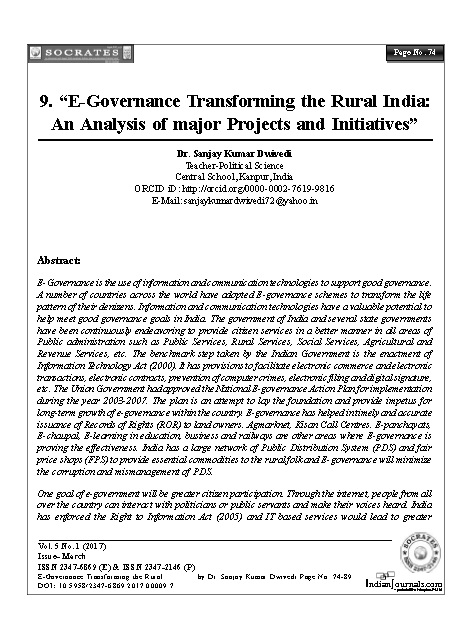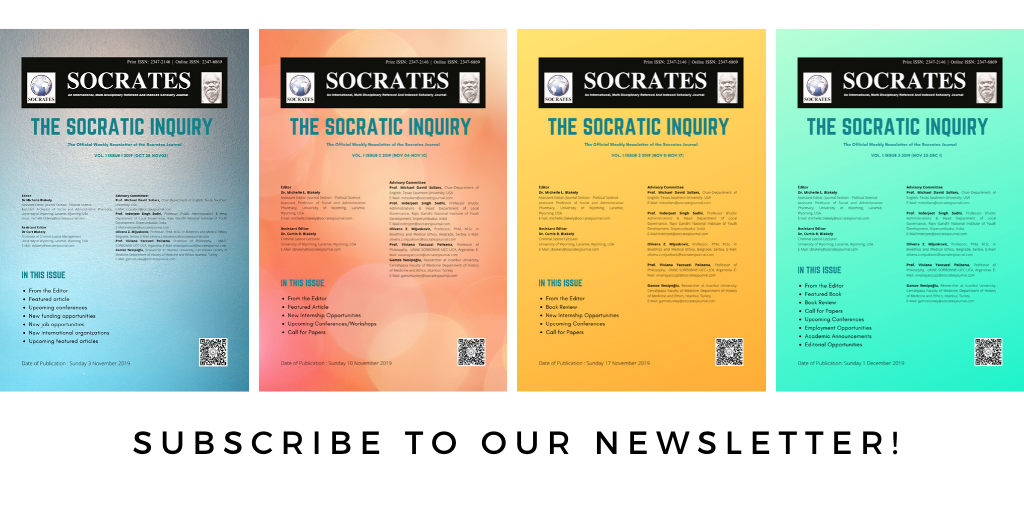E- Governance Transforming the Rural India
An Analysis of major Projects and Initiatives
DOI:
https://doi.org/10.5958/2347-6869.2017.00009.7Keywords:
E-Governance, Public Administration, Right to Information, Lokvani, IndiaAbstract
E-Governance is the use of information and communication technologies to support good governance. A number of countries across the world have adopted E-governance schemes to transform the life pattern of their denizens. Information and communication technologies have a valuable potential to help meet good governance goals in India. The government of India and several state governments have been continuously endeavoring to provide citizen services in a better manner in all areas of Public administration such as Public Services, Rural Services, Social Services, Agricultural and Revenue Services,etc. The benchmark step taken by the Indian Government is the enactment of Information Technology Act (2000) .It has provisions to facilitate electronic commerce and electronic transactions, electronic contracts, prevention of computer crimes, electronic filing and digital signature, etc. The Union Government had approved the National E-Governance Action Plan for implementation during the year 2003-2007. The plan is an attempt to lay the foundation and provide impetus for long-term growth of e-governance within the country. E- Governance has helped in timely and accurate issuance of Records of Rights (ROR) to land owners. Agmarknet, Kisan Call Centres. E- Panchayats, E- Chaupal, E-learning in education, business and railways are other areas where E- governance is proving the effectiveness. India has a large network of Public Distribution System (PDS) and fair price shops (FPS) to provide essential commodities to the rural folk and E- governance will minimize the corruption and mismanagement of PDS. One goal of e-government will be greater citizen participation. Through the internet, people from all over the country can interact with politicians or public servants and make their voices heard. India has enforced the Right to Information Act (2005) and IT based services would lead to greater transparency in providing information under this Act. India is a country of villages and several types of disputes arise there. The pending court cases have brought the legal system to a halt. The application of ICT in Supreme Court and High Courts has enabled the parties to get information about their cases from remote areas. Further it will not only save the money and time of citizens but will also reduce the backlog of cases. The Postal department has already started effective services like delivery of Money Orders through Extended Satellite Money Order (ESMO) centres in certain stations. These services are being provided with the help of satellite based Very Small Aperture Terminals (VSATs). There have been several successful initiatives and noteworthy projects undertaken in various states of India. Some of the successful initiatives are: Bhoomi (Karnataka), Gyandoot (M.P.), E-seva(Andhra Pradesh),ASHA (Assam),Lokmitra (HP), Gramdoot (Rajasthan),Lokvani (U.P.),Sari ( Tamilnadu), Akshaya (Kerala), SETU( Maharashtra) and SUDA( Gujarat), etc. This paper specifically focuses on the E-Governance initiatives that have changed the life style of rural citizens and in which the citizens derive benefit through direct transactions with the services provided by the union and the provincial governments. The paper also highlights the variety of constraints in implementing the E-governance projects in rural areas.
Article DOI : 10.5958/2347-6869.2017.00009.7
Downloads
Metrics
References
Bhatnagar, Subhash. (2004). E-government from Vision to Implementation. Sage, New Delhi
Goa best e-governed state in India: IDC (March 14, 2007). Retrieved from http://www.egovnews.org/ ?p=1784
Jain, Dinesh Kumar.(2011). Note on Mission Project on E-Panchayats. Kurukshetra, Publication Division, Govt. of India New Delhi ,Vol.59.No.3 , pp.38-40
Kalsi,N.S.,Ravi Kiran and Vaidya,S.C.(2009). Effective e-Governance for Good Governance in India. International Review of Business Research Papers V.5 No.1,p. 216
Kapur, Jagdish C. (2000). IT and Good Governance. The Indian Journal of Public Administration, July-September, p.395
Monga, A. (2008). E-government in India: Opportunities and challenges. JOAAG, Vol. 3.No. 2, p.56
Nandan, Shefali, ‘Lesson from E-government Initiatives in Uttar Pradesh’. p. 28 retrieved from http://www. csi-sigegov. org/egovernance_pdf/4_ 26-32.pdf on 9-3-11
Palekar , S.A., IPSA,Meerut.(2010). E-Governance Initiatives in India: An Analytical Study of Karnataka State. The Indian Journal of Political Science,Vol.71.No.1,p.92
Rajita,G. (2010). E-Government: Changing Rural Life Style. Yojana: Publication Division, New Delhi. Vol.54.No.11, p.32 Ibid,p.33
Suman, Yogesh and Nishy, P. (2009). ‘Taking IT to the Villages’, Science Reporter: NISCAIR, New Delhi. Vol. 46 No.12, pp.9-10
The Information and Technology Act,2000,New Delhi, Government of India Chapter, III, Para 6(1),p.10
The Information and Technology Act, 2000, (Amended 2008), New Delhi, Government of India.
Yadav, Akhilesh Chandra. (2010). ‘Panchayati Raj and E-Governance’, Kurukshetra: Publication Division, New Delhi .Vol.56 No.12,p.12

Downloads
Published
How to Cite
Issue
Section
License
Copyright (c) 2017 Dwivedi Sanjay Kumar, Dr.

This work is licensed under a Creative Commons Attribution-NonCommercial 4.0 International License.
Revised Copyright/CC license that applies to all the articles published after 05-02-2017
Attribution-NonCommercial 4.0 International (CC BY-NC 4.0)

Copyright/CC license that applies to all the articles published before 05-02-2017
Attribution-Non Commercial-No Derivatives 4.0 International (CC BY-NC-ND 4.0)

Author(s) will retain all the right except commercial and re-publishing rights. In the case of re-publishing, they will have to obtain written permission from the journal. Additional licensing agreements (Creative Commons licenses) grants rights to readers to copy, distribute, display and perform the work as long as you give the original author(s) credit, they can not use the works for commercial purposes and are not allowed to alter, transform, or build upon the work. For any reuse or distribution, readers and users must make clear to others the license terms of this work. Any of these conditions can be waived if you get permission from the copyright holders. Nothing in this license impairs or restricts the authors’ rights. To view a copy of this license, visit http://creativecommons.org/licenses/by-nc-nd/4.0/ or send a letter to Creative Commons, 171 Second Street, Suite 300, San Francisco, California, 94105, USA.
Research Papers published in SOCRATES are licensed under an Attribution-NonCommercial-NoDerivatives 4.0 International (CC BY-NC-ND 4.0)
























